
To Dangle or Not to Dangle
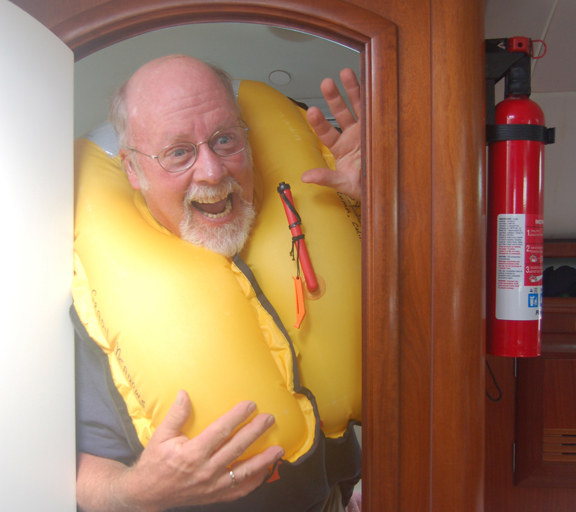
© Latitude 38 Media, LLC
While idling in the cockpit of Tom Lilienthal’s Beneteau 411 Dreamseeker last fall en route to Cabo San Lucas, we got into a friendly debate about the use of inflatable lifejackets. I’d noticed that both Captain Tom and crewman Grady Meadows liked to let the pull cords of their lifevests dangle freely, while I kept mine folded up within my vest so it couldn’t accidently snag on something.
Shortly afterwards Grady excused himself, muttering something about needing to go "Vote for George Bush." A few minutes later we heard a scream, followed by hilarious laughter. While ‘doing his business’ in the narrow salon head, Grady had inadvertently snagged his lifevest’s ripcord, causing it to instantly inflate. When we rushed below decks to see what all the ruckus was, we found Grady looking much like the Michelin man trying to eject himself from a phone booth.
Cruising is not for sissies — there’s all sorts of unexpected hazards out there.
A Life Lost, A Life Saved
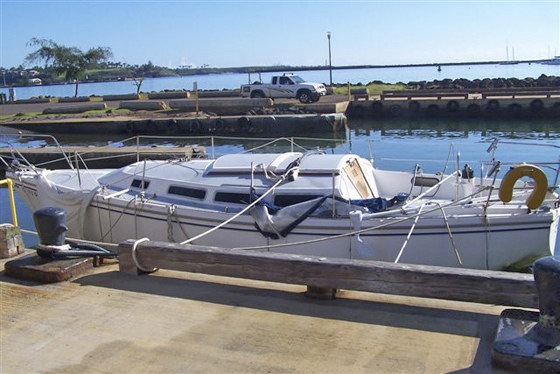
© Latitude 38 Media, LLC
The West Coast-based Catalina 30 Bug Trap was found dismasted and crewless about 19 miles off Kauai on Sunday. The Coast Guard reports that the boat’s owner, Darrin Frank Bunker of Aliso Viejo, set sail from Dana Point Harbor around 10 a.m. on October 3, bound for his new slip in San Diego. He was never heard from again. Bunker, a 42-year-old online game entrepreneur, was a novice sailor and had purchased Bug Trap just two months earlier.
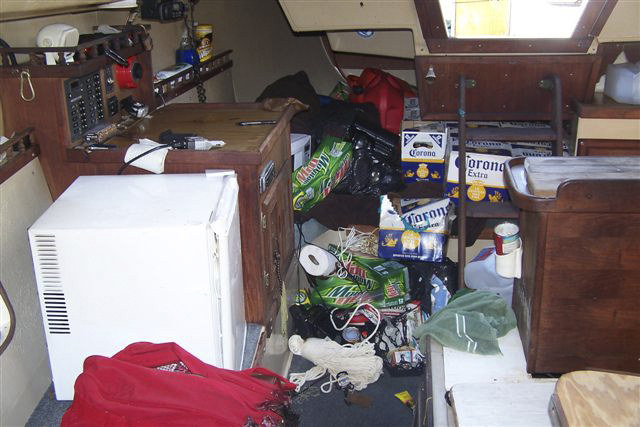
©2008 Latitude 38 Media, LLC
At this point, the Coast Guard can only speculate what happened after he left Dana Point but they think it’s possible that Bunker, arriving in San Diego after dark, decided to wait until daylight to enter the harbor. Evidence of a small fire in the cabin suggests that Bunker may have fallen asleep with a lit cigarette, igniting some upholstery. Their theory is that he may have woken up to flames, panicked and jumped overboard. The Catalina 30’s high freeboard would have made it nearly impossible to climb back aboard without a ladder. It’s believed the boat was dismasted while drifting across the Pacific.
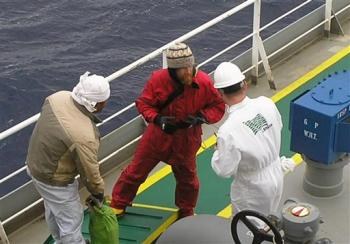
Meanwhile, near the Bahamas, William Archer, 32, was rescued from his sinking 39-ft sailboat Alchemy on January 3 by the crew of the tanker Omega Lady Sarah. Archer, a Ft. Lauderdale sailing instructor, was singlehanding Alchemy from the Cape Verde Islands, bound for Antigua, when a storm shredded two of his sails and broke his boom early in his voyage. He continued getting battered by storms until he reached the Bahamas, where his engine failed and the boat began taking on water at an alarming rate. Spotting the Omega Lady Sarah on the 42nd day of his ill-fated trip, Archer fired a flare, catching the tanker’s attention. After being plucked from his liferaft, which was tethered to his sinking boat, he told the crew he hadn’t eaten solid food in a week. He was taken to a Nassau hospital for evaluation and released.
The Elusive ‘Long-Stay Visa’
It’s the time of year when dozens of cruisers are currently preparing to embark on the so-called Pacific Puddle Jump from the Americas to French Polynesia. A hot topic of conversation among them is how to get a ‘long-stay’ (six month) visa, since most American cruisers are only granted a three-month visa upon arrival. Below, veteran SoPac cruiser Susan Chamberlin of the Schumacher 46 Surprise explains how to insure an extended stay:
"Steve and I crossed to French Polynesia in March, 2007. Because we wanted to take our time, we applied for and received long stay visas. If you want to get this visa apply now! We were told it would take three to four months. We applied November 1 and were notified the visas were ready for pick-up in mid-February. This meant a trip back from Mexico for one of us — an additional expense.
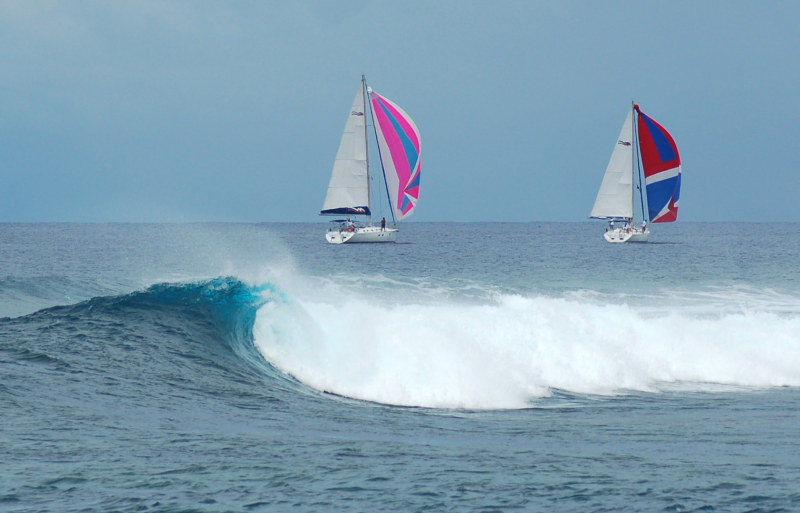
© Latitude 38 Media, LLC
"The process is pedantic, but not insurmountable. Go to the website for the French consulate in San Francisco (assuming this is the closest for most Puddle Jumpers) at www.consulfrance-sanfrancisco.org. It will come up in French. Look in the upper left hand corner for the small U.S. flag and click to get to English. Under ‘The Consulate’ click on ‘Visas for France’. Click on ‘Long Stay Visa’ and print out the instructions to have a check list of what you need. Then go to ‘Forms and Applications’, and download the application for a long stay visa and the translation of this form. When you fill out the application make sure you answer in French. Also make sure you write dates in Day/Month/Year format.
"The list of items to be submitted is very clear. We purchased an international travel policy online. It did not actually pay for medical coverage overseas, but did cover repatriation of remains in case of death. We did not translate the policy, just highlighted the coverage which was deemed satisfactory. It turns out that getting the letter from your police department is routine. In Richmond it took a week and cost $15. Provide a translation of the letter. Be wary of free web-based translation programs, as they produce some very strange results. For proof of financial guarantee, you should submit a recent bank or brokerage account statement. We gave them three months just for good measure. Don’t try a 1099, as someone did at the time I was there — it was not accepted. The $1800/person/month of stay is their threshold level. And by the way, if you don’t have that much in the bank then don’t go there. Not that you will actually spend that much, but most everything is very expensive. So if you want to eat out and have a drink occasionally, or need to replenish your wine supply, it will rapidly add up. With respect to ‘lodging’ we provided our boat documentation and boat insurance policy. Finally, write your little letter about why you want a long stay visa and have it translated. I simply stated we were interested in the history and culture of French Polynesia and wanted the opportunity to experience the islands in depth.
"Once you have all your documents, or are close, go back to the website and make an appointment, noting that long stay visa applicants are taken only on Monday and Wednesday afternoons, and that you need a separate appointment for each applicant. If you don’t have an appointment you will not get past the security guard.
"All applicants must appear in person as they will take your fingerprints and enter them in a biometric database, along with your photo. You can pay the $152 for each visa by credit card. They will not keep your passports. Once your application is accepted at the French Consulate you just wait. The entire application package is sent to Tahiti and processed there, hence the long lead time. When your visa is approved by Tahiti, the consulate will call you. I asked that they email us, since we would not be home, but that didn’t happen. So check your answering machine frequently, or give them a business number to call. Only one of you needs to pick up the visa(s), but you need each passport, as they will be permanently affixed in the passport. As I recall, I did not need an appointment to pick up our visas.
"Was it worth it? Yes, for us it was. It was nice to know we didn’t have to keep to a schedule, or move when the weather wasn’t favorable. We had planned on purchasing the international travel policy in any case. The only other bureaucratic piece was the police clearance letter. Doing the translations helped me brush up on my French. We spent nearly six months in French Polynesia and left the boat in Raiatea where we will rejoin her next April. When we return we will have two options: stay just 30 days under the normal time extended to U.S. visitors or apply for an extension to our Carte de Sejour, which we secured in Papeete. But that’s another story.
"One more piece of information: Previously you could extend your time in French Polynesia by leaving and then returning — for example, flying to the Cook Islands. While you do get credit for time you are away from French Polynesia it is limited to the duration of your time away. So if you are gone a week, then your 30- or 90-day visa is extended by just seven days. In order to restart the 30 day clock, you must leave French Polynesia for the duration of your previous stay. In our case we can’t return before March 27, or six months from our departure date."
Look for further details on the upcoming Pacific Puddle Jump here, and in the pages of Latitude 38.
Anybody Up for a Swim?
You think it’s been cold lately sailing on San Francisco Bay? Try swimming in it — without a wetsuit!
Sound impossible? Not really. Believe it or not, there is an elite group of swimmers who regularly swim in Bay waters wearing only normal bathing suits and swimming caps. How they do it without turning blue and chattering their teeth right out of their heads is a mystery to us, but they do.
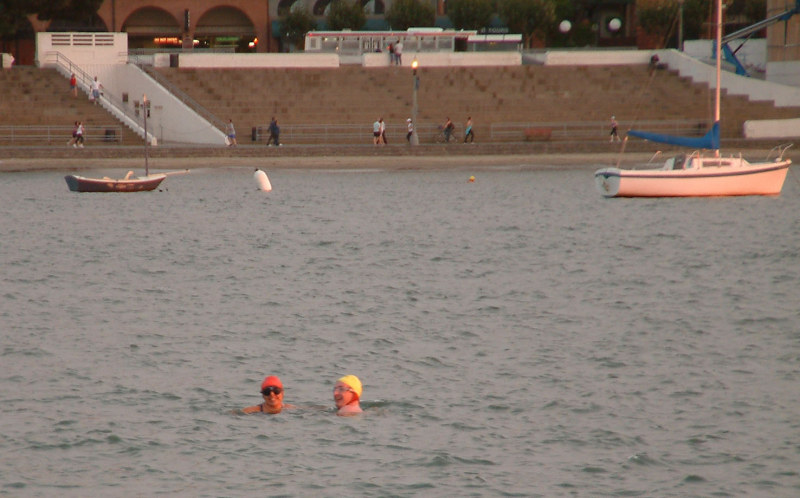
©2007 Latitude 38 Media, LLC
"Keep a sharp lookout for swimmers!" we cautioned our guests during a recent late-afternoon daysail with friends. We were just about to swing our bow into San Francisco’s Aquatic Park. Sure enough, there ahead of us was a middle-aged couple leisurely stroking across the anchorage only minutes before sunset. Our guests were dumbfounded, but managed a smile and a wave. Of course, whenever and wherever you sail you always need to keep a lookout, but be especially careful in or near the Park — even when it feels cold enough to snow!
